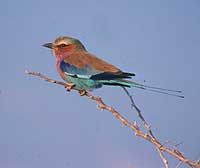Bird watching
Kruger National Park
 There are over 500 bird species in the Kruger Park area, some are very specific to this area alone. Birding throughout the entire park is rewarding and the park's numerous water points, rest camps and picnic sites make for excellent birding oportunities.
There are over 500 bird species in the Kruger Park area, some are very specific to this area alone. Birding throughout the entire park is rewarding and the park's numerous water points, rest camps and picnic sites make for excellent birding oportunities.
If you are a keen birder, then the very Northern part of the Kruger park is the place to visit, as is regarded as one of the top destinations for birding in South Africa.(Pafuri and Punda Maria regions)
The parks' 5 bushveld camps all offer superb birding opportunity as they are smaller camps with less traffic and all of these camps have hides or viewing platforms that further enhance birding.
Camps in general still attract a lot of birds as there is a dense concentration of trees and shrubs and they are usually next to rivers or dams.
Birders can look forward to viewing the big 6 in the Kruger Park: (Saddle-billed Stork, Kori Bustard, Martial Eagle, Lappet-faced Vulture, Pel's Fishing-Owl and Ground Hornbill).
KwaZulu-Natal
The KwaZulu-Natal area boasts about 470 species of birds being regularly recorded reflecting the diverse habitats found in KwaZulu-Natal..
The coastal plain is influenced by the warm Mozambique current, with the result that a number of tropical birds push to their southernmost extremity there. Some of these are species absent from the rest of South Africa.
Other tropical species spread south on a broader front, sometimes occupying the whole of KZN. None of these is a South African endemic, but a few are endemic to the coastal plain, just extending into Mozambique. Many are breeding migrants, retreating to equatorial Africa in winter.
The KZN interior is structurally diverse - forests, woodlands, grasslands, wetlands - although these habitats are not unique to KZN. Here the tropical birds mingle with species spreading from the western half of southern Africa. These latter are year-round residents, although some migrate short distances to lower altitude in winter. Most of the widespread species come from the southern and western Cape.
KZN’s alpine species are a mixture of Karoo birds at their easternmost limit, and species confined to high altitude. Many of these are endemics. A number of north-western KZN birds are more typically associated with the Kalahari or highveld. Much of the diversity of KZN is accounted therefore by its unique position at the crossroads of two, and by some definitions four avifaunas.
It also receives a substantial proportion of the Palaearctic migration that graces Africa each summer. One consequence of KZN’s crossroads position is that no species is endemic to the province.
The importance of KZN in conserving South Africa’s birds is reflected in the number of Red Data species present. Of the 62 species currently listed, 49 occur regularly in KZN, and KZN makes a major, or the only contribution towards the conservation of 26 of them.
Birding in the rest of South Africa
The largest colony of Cape Vultures in the world (around 800 breeding pairs) are found in the Marakele National Park . However the park is also appealing to birders as it falls within the transition zone between the dry western regions and the moister eastern regions of the country. Thus it is possible to see certain closely related species alongside one another. This park is also an excellent place to look for raptors, with many species using the uplift generated off the cliff faces of the Waterberg to ride thermals.
Kalagadi Transfrontier Park boasts some 280 species of birds. Of these, approximately 92 are resident. A variety of raptors may be seen. Birding can be very rewarding after the rains in this arid area.
The mountains offer a good habitat for raptors and most parks found in mountainous areas offer good sightings of these birds soaring on the thermals - especially Golden Gate Highlands and Mountain Zebra Park
There is a rich variety of birds found along the coast. The East coast being warmer and forested. The Knysna Lourie is a popular bird to view in the Wilderness and Tsitsikamma area. The cold Atlantic running along the West coast with a drier coast line. The West coast is also popular during its flower season.
Some of the parks offer a range of habitats and avifaunas within their own boundries giving birders wonderful variety.
